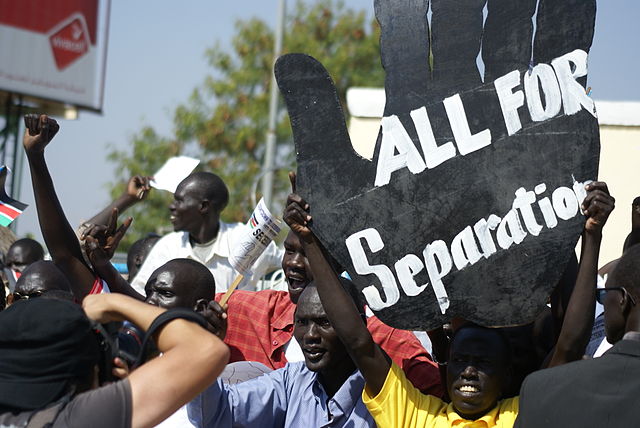Top Qs
Timeline
Chat
Perspective
Separatism
Advocacy for separation from a larger group From Wikipedia, the free encyclopedia
Remove ads
Separatism is the advocacy of cultural, ethnic, tribal, religious, racial, regional, governmental, or gender separation from the larger group. As with secession, separatism conventionally refers to full political separation. Groups simply seeking greater autonomy are usually not considered separatists.[1] Some discourse settings equate separatism with religious segregation, racial segregation, or sex segregation, while other discourse settings take the broader view that separation by choice may serve useful purposes and is not the same as government-enforced segregation. There is some academic debate about this definition, and in particular how it relates to secessionism, as has been discussed online.[2]
This article has multiple issues. Please help improve it or discuss these issues on the talk page. (Learn how and when to remove these messages)
|
Separatist groups practice a form of identity politics, or political activity and theorizing founded in the shared experiences of the group's members. Such groups believe attempts at integration with dominant groups compromise their identity and ability to pursue greater self-determination.[3] However, economic and political factors usually are critical in creating strong separatist movements as opposed to less ambitious identity movements.[4]
Remove ads
Motivations
Summarize
Perspective



Groups may have one or more motivations for separation, including:[5]
- Emotional resentment and hatred of rival communities.
- Protection from genocide and ethnic cleansing.
- Resistance by victims of oppression, including denigration of their language, culture or religion.
- Influence and propaganda by those inside and outside the region who hope to gain politically from intergroup conflict and hatred.
- Economic and political dominance of one group that does not share power and privilege in an egalitarian fashion.
- Economic motivations: seeking to end economic exploitation by more powerful group or, conversely, to escape economic redistribution from a richer to a poorer group.
- Preservation of threatened religious, language or other cultural tradition.
- Destabilization from one separatist movement giving rise to others.
- Geopolitical power vacuum from breakup of larger states or empires.
- Continuing fragmentation as more and more states break up.
- Feeling that the perceived nation was added to the larger state by illegitimate means.
- The perception that the state can no longer support one's own group or has betrayed their interests.
- Opposition to political decisions.
Remove ads
Types
Summarize
Perspective
Ethnic separatism can be based on cultural, linguistic as well as religious or racial differences. Ethnic separatist movements were relevant since they represented historical delineations between states, or in recent times, were the cause of conflicts between peoples in Europe, Africa and Asia with different ethnic/linguistic origins.
Separatism by continent


Gender separatism
The relationship between gender and separatism is complex.[6] Feminist separatism is women's choosing to separate from ostensibly male-defined, male-dominated institutions, relationships, roles and activities.[7] Lesbian separatism advocates lesbianism as the logical result of feminism. Some separatist feminists and lesbian separatists have chosen to live apart in intentional community, cooperatives, and on land trusts.[8] Queer nationalism (or "Gay separatism") seeks a community distinct and separate from other social groups.[9][10] On the other hand, the MGTOW movement is sometimes considered a male-gender separatism, as at the center of this ideology is the notion of male separatism where men should not be a part of a feminist-biased society. Some fringe elements even propose a utopical no-women state.[11][12][13]
Geographical and socioeconomic separatism

Some examples include:
- Alberta separatism
- Berber separatism in North Africa
- Bougainville independence movement
- Cape Independence
- Casamance independence movement
- Cascadian separatists
- Catalan independence movement
- Provisional Revolutionary Government of Cibao
- Euskadi (Basque Country) independence movement
- Hong Kong independence movement
- New England New State Movement
- Malaysian Sabah and Sarawak separatists
- West Papuan independence
- Free South movement
- Quebec sovereignty movement
- Scottish independence movement
- Taiwanese independence movement
Racial separatism
The examples and perspective in this section deal primarily with the United States and do not represent a worldwide view of the subject. (August 2011) |
Some separatist groups seek to separate from others along racial lines. They oppose interracial marriage and integration with other races and seek separate schools, businesses, churches and other institutions, and often separate societies, territories, countries, and governments:

- Black separatism (also known as black nationalism) is the most prominent wave advancing the concepts of "Black racial identity" in the United States and has been advanced by black leaders like Marcus Garvey and organizations such as the Nation of Islam. Critical race theorists like New York University's Derrick Bell and University of Colorado's Richard Delgado argue that US legal, education and political systems are rife with blatant racism. They support efforts like "all-black" schools and dorms and question the efficacy and merit of government-enforced integration.[14] In 2008 statements by Barack Obama's former pastor Jeremiah Wright, Jr., revived the issue of the current relevance of black separatism.[15]
- Latin American concepts of racial identity such as the bronze race and La Raza Cósmica are found in the small separatist Raza Unida Party. The Chicano Movement (or Chicano nation) in the United States sought to recreate Aztlán, the mythical homeland of the Aztecs comprising the Southwestern United States.[16]
- White separatism in the United States and Western Europe seeks separation of the white race and limits to nonwhite immigration under the argument that these policies are necessary for the white race's survival.
Religious separatism
This section possibly contains original research. (November 2015) |

Religious separatist groups and sects want to withdraw from some larger religious groups and/or believe they should interact primarily with coreligionists:[citation needed]
- English Christians in the 16th and 17th centuries who wished to separate from the Church of England and form independent local churches were influential politically under Oliver Cromwell, who was himself a separatist. They were eventually called Congregationalists.[17] The Pilgrims who established the first successful colony in New England were separatists.[18]
- Christian separatist groups in Indonesia,[19][20] India[21] and South Carolina (United States)[22][23]
- Zionism sought the creation of the State of Israel as a Jewish homeland, with separation from gentile Palestinians. Simon Dubnow, who had mixed feelings toward Zionism, formulated Jewish Autonomism, which was adopted in eastern Europe by Jewish political parties such as the Bund and his own Folkspartei before World War II.[24] Zionism can also be seen as somewhat ethnic too, however, as its definition of who is Jewish has often included people of Jewish background who do not practice the Jewish religion. It is further complicated as some who had ancestors who converted to Judaism, such as some Ethiopian Jews, may not share ethnic history with the Jews, however, are considered to be so but not without debate.[25]

- The Partition of India and (later Pakistan and Bangladesh) arose as a result of separatism on the part of Muslims.
- The demand for an independent Sikh homeland called Khalistan emerged during the 1970s and 1980s amid political tensions in Punjab, particularly surrounding the Anandpur Sahib Resolution, which primarily sought greater autonomy for Punjab and the protection of Sikh identity within the Indian Union. Escalation occurred when armed militants led by Jarnail Singh Bhindranwale occupied the Harimandir Sahib (Golden Temple) complex. In June 1984, the Government of India launched Operation Blue Star to remove the militants from the site. The military action resulted in casualties, including civilians, and caused deep anguish among many Sikhs globally.
Later that year, the assassination of Prime Minister Indira Gandhi by her Sikh bodyguards led to the tragic 1984 anti-Sikh riots, in which thousands of Sikhs were killed. While these events led to a rise in support for the Khalistan movement in some sections of the Sikh diaspora, the movement steadily declined in India by the 1990s.
Today, Sikhs in India are equal citizens under the Constitution, and actively contribute to the country’s political, military, economic, and cultural life. The idea of Khalistan holds little to no support among Indian Sikhs, and is generally viewed as a fringe movement, largely sustained by diaspora activism abroad. Attempts to revive it within India have consistently failed to gain traction.[26]
- Muslim separatist groups in the Philippines (Mindanao and other regions: Moro Islamic Liberation Front, Abu Sayyaf), in Thailand (see also South Thailand insurgency), in India (see also Insurgency in Jammu and Kashmir), in the People's Republic of China (Xinjiang: East Turkestan Islamic Movement), Tanzania (Zanzibarian separatist movements), in the Central African Republic (Regions that are inhabited by Muslims: Séléka), in Russia (in the Northern Caucasus, especially in Chechnya: Caucasus Emirate), in Yugoslavia (Bosnia and Herzegovina: Alija Izetbegovic espoused an Islamic inspired separatism)
Remove ads
Governmental responses

How far separatist demands will go toward full independence, and whether groups pursue constitutional and nonviolent action or armed violence, depend on a variety of economic, political, social and cultural factors, including movement leadership[27] and the government's response.[4] Governments may respond in a number of ways, some of which are mutually exclusive. Some include:[28]

- accede to separatist demands, independence
- improve the circumstances of disadvantaged minorities, be they religious, linguistic, territorial, economic or political
- adopt "asymmetric federalism" where different states have different relations to the central government depending on separatist demands or considerations
- allow minorities to win in political disputes about which they feel strongly, through parliamentary voting, referendum, etc.
- settle for a confederation or a commonwealth relationship where there are only limited ties among states.
See also
Lists
General
- Annexation
- Autonomism (political doctrine)
- Ethnic nationalism
- Ethnic minority
- Ethnocentrism
- Homeland
- Identity politics
- Intersectionality
- Kinship
- Language secessionism
- Micronation
- Military occupation
- Multiculturalism
- Minority group
- Nation
- Polarization
- Partition
- Refugee
- Secession
- Stateless nation
- Unrepresented Nations and Peoples Organization
Remove ads
References
Further reading
External links
Wikiwand - on
Seamless Wikipedia browsing. On steroids.
Remove ads